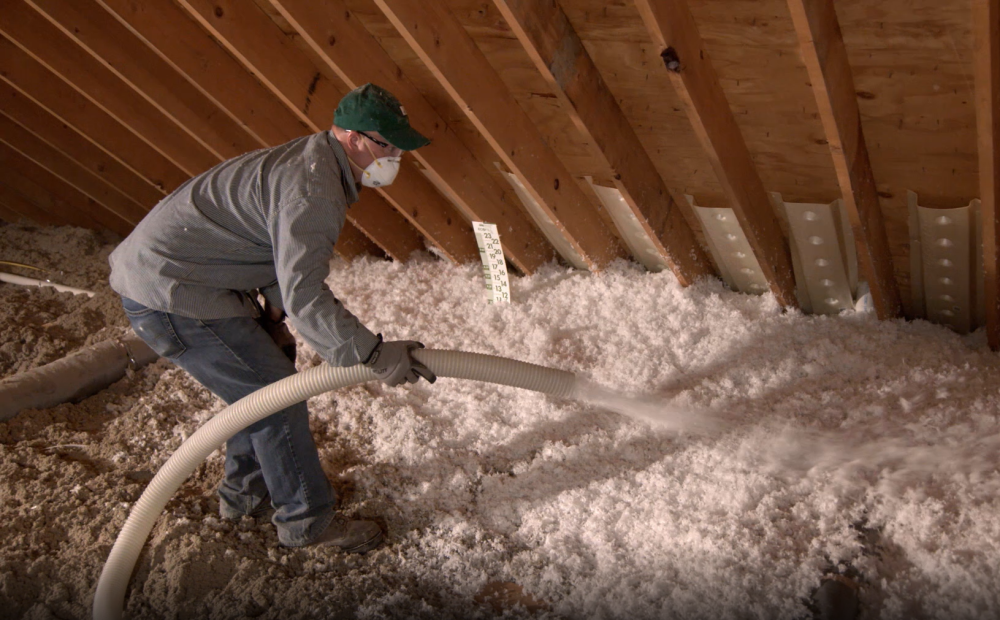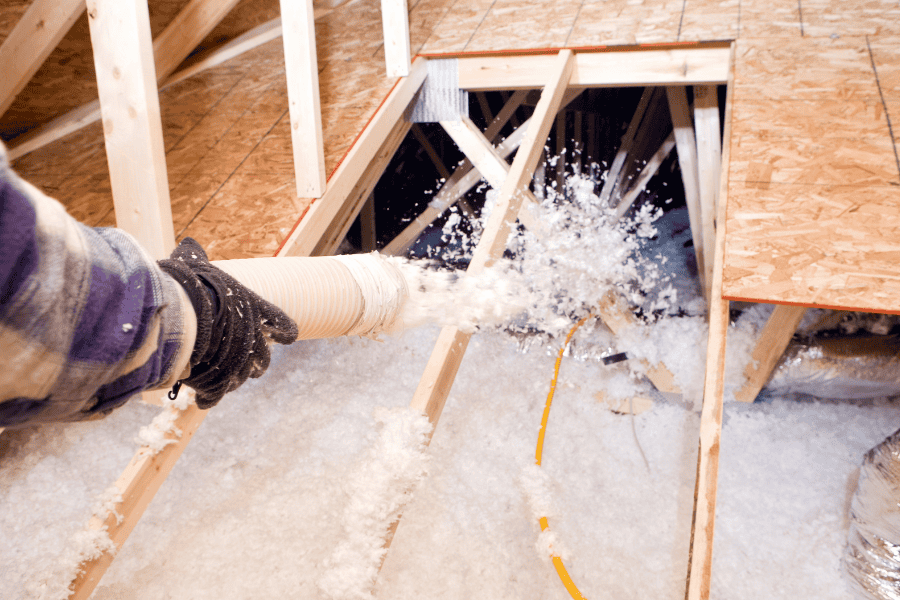Blown-in insulation in the attic can extend the life of your roofing materials by creating a stable, controlled environment that protects the roof’s structure from the inside out. In a hot climate, a thick, seamless layer of blown-in insulation on the attic floor creates a powerful thermal barrier. This prevents the intense heat of a 140-degree attic from constantly baking the underside of the roof deck and the shingles, which can significantly slow down their aging process. In a cold climate, a properly air-sealed and insulated attic prevents the formation of destructive ice dams, which are a leading cause of roof leaks and water damage. By mitigating these extreme temperature and moisture cycles, blown-in insulation experts help the entire roofing system reach its full, intended lifespan.
Understanding how an attic’s condition affects the roof reveals why a professional blown-in insulation upgrade provides such a powerful layer of long-term protection. The information is based on the practical, hands-on experience of building performance professionals who understand that a durable roof is part of a complete, high-performance system.
The Attic: Your Home’s Most Hostile Environment
The attic is often the most overlooked part of a home, but it is a space that is subject to the most extreme temperature swings, and this has a direct impact on the roof above it.
The Summer Problem: Extreme Heat
On a sunny summer day, the temperature of a dark-colored roof can easily exceed 150 degrees. This intense heat radiates downwards, and even with vents, the temperature inside a standard attic can soar to 130 degrees or more. This super-heated air is in constant contact with the underside of your roof’s wooden sheathing and the shingles that are attached to it.
This extreme, prolonged heat is very damaging to the roofing materials. It can:
- Accelerate the Aging of Shingles: The heat bakes the asphalt in the shingles, causing it to become brittle and lose its flexibility. This leads to cracking and the loss of the protective granules, which are the shingle’s first line of defense against the elements.
- Degrade the Wood Sheathing: The high heat can dry out the wood of the roof deck, making it more prone to warping and delamination over time.
The Winter Problem: Moisture and Ice Dams
In a colder climate, a poorly insulated attic can be just as damaging in the winter. Heat from the living space below leaks into the attic, warming the underside of the roof deck. This melts the snow on the roof, and the water runs down until it reaches the cold eaves, where it refreezes. This process repeats, building a “dam” of ice that can back water up under the shingles, leading to serious leaks, rot, and water damage to the roof deck, the insulation, and the ceiling below.

How Blown-in Insulation Provides a Protective Barrier
A professional attic insulation upgrade, which includes both air sealing and the installation of a thick layer of blown-in insulation, is designed to solve both of these problems.
Creating a Powerful Thermal Barrier
Blown-in insulation, whether it is fiberglass or cellulose, is installed using a hose to create a thick, seamless, and uniform blanket over the entire attic floor. This creates a high-R-value thermal barrier that is extremely effective at stopping the transfer of heat. In the summer, it keeps the intense attic heat from getting into your house, but it also keeps that heat from radiating down and over-heating the ceiling and the rooms below. While it does not cool the attic itself, it is the first step in creating a more controlled environment.
The Critical Importance of Air Sealing
For blown-in insulation to be truly effective at protecting the roof, it must be paired with a thorough air sealing of the attic floor. This is the process of finding and sealing all the small gaps and cracks that allow air to move between the living space and the attic. In the winter, this is what stops the warm, moist air from leaking into the attic and causing the condensation and frost that lead to ice dams and rot.
Here is a look at the two main types of blown-in insulation:
| Blown-in Insulation Type | Key Characteristics |
|---|---|
| Fiberglass | Made from spun glass fibers. It is lightweight, will not settle over time, is naturally fire-resistant, and is not a food source for mold. |
| Cellulose | Made from recycled paper products that are treated with a fire retardant. It is slightly denser than fiberglass and can be very effective at filling small gaps. |
Bonus Tip: A professional installer will always install baffles at the eaves of the roof before they blow in the new insulation. These baffles create a channel that ensures the soffit vents are not blocked, which is essential for maintaining proper attic ventilation.
While upgrading a standard vented attic is a major improvement, modern building science offers an even more comprehensive approach to protecting the roof.

The Ultimate Solution for Roof Protection: A Conditioned Attic
While a well-insulated and air-sealed vented attic is a major improvement, the most effective way to protect a roof from the inside out is to create a “conditioned” or “unvented” attic.
How a Conditioned Attic Works
This is a modern building science strategy where, instead of insulating the attic floor, a material like closed-cell spray foam is applied directly to the underside of the roof deck. This brings the entire attic space inside the home’s “conditioned envelope.”
The result is a dramatic change in the attic’s environment. Instead of being a 140-degree oven in the summer and a freezing cold space in the winter, the attic now stays within 5-10 degrees of the temperature of the main house. This completely eliminates the extreme temperature swings and the moisture issues that are so damaging to the roofing materials. The roof deck and the shingles are now in a stable, protected environment, which is the key to a long and healthy lifespan.
Things to Consider for Your Attic Project
- A Professional Inspection is the First Step: A qualified insulation contractor can do a thorough inspection of your attic to identify the key areas of energy loss and help you create a prioritized plan for improvement.
- A Systems-Based Approach: For the best results, it is important to think of your home as a complete system. The insulation, the air barrier, and the ventilation system all need to work together. A professional will be able to design a system that is right for your home.
- Address Any Existing Leaks First: Before you invest in new insulation, it is critical to have your roof professionally inspected to ensure there are no existing leaks. Insulating over a problem will only make it worse.
A Healthier Roof Starts in the Attic
The insulation in your attic is a critical, though often overlooked, component of your home’s entire roofing system. By creating a stable, controlled environment, a professional blown-in insulation upgrade can protect your roof’s structure and its materials from the damaging effects of extreme temperatures and moisture. It is a smart, proactive investment that can help you avoid costly, premature repairs and ensure that your roof provides a long and reliable service life.
Get a Professional Attic and Roof Assessment
To find out how a professional insulation upgrade can help to protect your roof and extend its lifespan, the best first step is a professional evaluation. An experienced insulation contractor can assess your attic’s current condition and provide a clear, data-driven plan for improving its performance. For homeowners looking for an expert opinion, the team at Prestige Insulation Solutions has deep expertise in all aspects of attic insulation and home performance. They can be reached for a consultation by email at [email protected] or by phone at (850) 429-4969.
Author: Rene Zamarripa, a spray foam installer and owner, began his career in the insulation industry in 2008 with Key Insulation in San Antonio. After 17 years of hands-on experience, he now owns a successful insulation company with aspirations to franchise. He is knowledgeable in R-values, insulation processes, and various components used in both residential and commercial applications and is experienced in identifying the right insulation solutions for different structures, including spray foam, fiberglass, and cellulose. Trained in operating spray foam rigs, Rene manages temperature and pressure settings, ensures proper material mix, and follows safety standards. He understands the technical and practical skills required to deliver consistent, high-quality insulation and guide others in the trade.
Reviewer: With over 13 years in spray foam insulation, Benjamin Lee reviewed this content and offered feedback aimed at helping growing businesses connect with local homeowners and commercial clients more effectively.